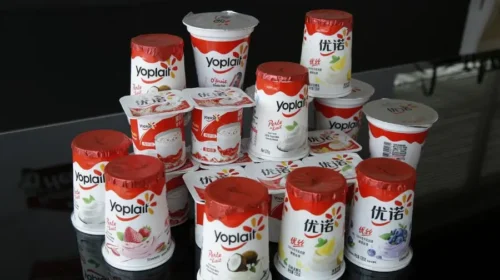Five millennials’ robotic dream heads for capital market with CRP listing bid

Industrial robot specialist CRP Robot Technology is the latest from its class rushing to make a Hong Kong IPO, hoping to seize on a recent craze for robotic stocks
Key Takeaways:
- CRP Robot has filed for a Hong Kong IPO, ranking first in China last year by revenue for welding robot makers
- The company’s profitability remains volatile, including a loss of 12.94 million yuan last year and an 8.44 million profit in the first half of 2025
By Lau Chi Hang
Wang Xingxing, founder and CEO of the wildly popular Chinese robotics firm Unitree, recently said that if the past decade represented a “sprouting and exploration” phase for robots, the next 10 years will see their “growth and blossoming.” He predicted robots will quickly evolve from devices that are merely “capable of movement” to ones that are “capable of tasks,” transitioning from “industry tools” to “daily companions.”
Whether Wang’s words actually come true remains up for debate, as robots make rapid advances in all shapes and forms. What’s clearer, meanwhile, is that the product class has become a flavor-of-the-day among Chinese investors, driving huge demand and large gains for almost anything billing itself as a robotic stock.
The latest company feeding into that frenzy is Chengdu CRP Robot Technology Co. Ltd., which submitted an application to list in Hong Kong last week.
CRP reported revenue of 156 million yuan ($21.95 million) in the first half of this year, up 36% year-on-year, and turned a profit of 8.44 million yuan for the period. Such performance stands out from its growing group of Hong Kong-listed robotics peers, most of whom remain profit-challenged.
CRP’s business centers on three main segments: industrial robots, which are its core area, along with collaborative and embodied intelligent robots. The company was China’s largest maker of welding robots last year based on revenue, according to third-party market data in its prospectus. It’s also a leader in robot applications for China’s metal and machining sector.
A dream realized
CRP’s founding is the story of a dream come true for five millennial entrepreneurs born after 1980. In 2012, when industrial robots were primarily still imported, Deng Shihai and four friends were convinced that domestically produced robots would one day become mainstream as China’s economy rapidly developed. Pooling 500,000 yuan in capital, or about $70,000, they charged headlong towards their vision.
Operating on a shoestring budget, they set up shop in a small space at an industrial park for student entrepreneurs in the city of Chengdu, capital of Southwest China’s Sichuan province, starting with a focus on robot controllers. After repeated trials, failures and exploration, CRP’s controllers gradually found a place in the market. However, sticking solely to such components wasn’t sustainable, and they determined they needed to produce complete robots to ensure their longer-term viability.
The founders intensely debated that shift, aware it meant abandoning their comfort zone and committing significant capital to a high-risk gambit that could easily spell the end of their company if things didn’t work out. But the gamble paid off, fortunately for them, and the company found a successful niche producing welding robots. Since then it has secured four rounds of funding, advancing its growth.
Volatile performance
CRP’s profitability compared with its money-losing peers is an important selling point for investors. But a closer look at its financials shows such profits are hardly a routine matter. Its profit plunged from 28.27 million yuan in 2022 to just 1.69 million yuan a year later. Then it fell into the red with a loss of 12.94 million yuan last year, before returning to the black again in the first half of this year. That shows CRP has yet to find stable footing, and sustainable profits could remain elusive.
The company’s cash flow is similarly unstable. Its operating cash flow stood at a positive 26.7 million yuan in 2022, but turned negative with outflows of 30.88 million yuan and 17.76 million yuan in 2023 and 2024, respectively. It only became positive again in the first half of this year, when the company recorded an inflow of 8.88 million yuan.
Complicating its prospects, the outlook for welding robots that provide over half of CRP’s revenue is not particularly compelling. China’s welding robot market grew from 7 billion yuan in 2020 to 8.4 billion yuan last year, representing an annual growth rate of just 4.4%, according to third-party market data in the prospectus. The market is expected to expand from 9.3 billion yuan this year to 15.3 billion yuan in 2029, implying a pickup in growth to 13.4% annually.
No commanding lead
Despite its position as China’s top welding robot manufacturer by revenue, CRP’s sales were hardly huge at just 137 million yuan last year. But the second- and third-ranked players weren’t far behind, with revenue of 128 million yuan and 120 million yuan, respectively. That shows CRP is hardly secure in its industry-leading status, and could easily be overtaken by one of its rivals at any time.
By comparison, the company ranks third among its Chinese peers in metal and machining industrial robots. But with just 156 million yuan in revenue for that segment last year, it’s a distant third behind the top two players, which had 939 million yuan and 733 million yuan, respectively. Catching up to these far larger competitors looks challenging.
Among pure-play robotics companies listed in Hong Kong, the larger Ubtech Robotics (9880.HK) reported revenue of 1.31 billion yuan last year, commanding a price-to-sales (P/S) ratio of 44 times. Geekplus Technology (2590.HK), with revenue of 2.4 billion yuan, trades at a lower but still healthy P/S ratio of 12.3 times. CRP’s revenue is significantly smaller than both. Even giving it a generous P/S ratio of 20 times, based on its profitability and current hot market sentiment, would still give the company a market capitalization of under HK$5 billion – well below the $1 billion cut-off for coveted “unicorn” status.
To subscribe to Bamboo Works weekly free newsletter, click here






